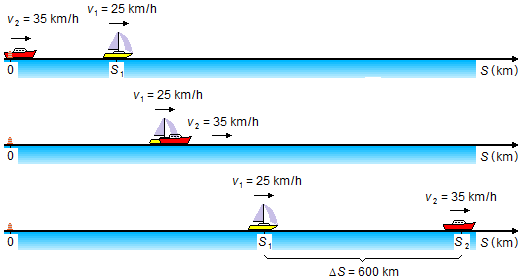Solved Problem on One-dimensional Motion
advertisement
Two boats depart from the same point and travel on the same straight line, with a constant speed of 25 km/h and 35 km/h. Communication between the two boats is possible by radio as long as the distance between them does not exceed 600 km. Find the time interval during which the two boats can communicate, in the following cases:
a) The two boats move in the same direction;
b) The slower boat departs two hours before the other and moves in the same direction;
c) The two boats depart at the same time and move in opposite directions.
Problem Data:
- Boat 1 speed: v1 = 25 km/h;
- Boat 2 speed: v2 = 35 km/h;
- Maximum communication distance: Δt = 600 km.
We choose a reference frame with the positive axis pointed to the right (Figure 1).

Let us consider that the point from which the boats depart is the origin of the reference frame S01 = S02 = 0
Solution
a) The boats move at constant speeds, the equations of displacement as a function of time is given by
\[
\begin{gather}
\bbox[#99CCFF,10px]
{S=S_0+vt}
\end{gather}
\]
writing this equation for the two boats
\[
\begin{gather}
S_1=S_{01}+v_1 t\\[5pt]
S_1=0+\left(25\;\mathrm{\small{\frac{km}{h}}}\right)t\\[5pt]
S_1=25\left(25\;\mathrm{\small{\frac{km}{h}}}\right)t \tag{I-a}
\end{gather}
\]
\[
\begin{gather}
S_2=S_{02}+v_2 t\\[5pt]
S_2=0+\left(35\;\mathrm{\small{\frac{km}{h}}}\right)t\\[5pt]
S_2=\left(35\;\mathrm{\small{\frac{km}{h}}}\right)t \tag{I-b}
\end{gather}
\]
The faster boat 2 moves away from boat 1 until the distance between them is greater than 600 km, and
communication is no longer possible (Figure 2).

Calculating the difference between the two equations (I-a) and (I-b)
\[
\begin{gather}
\frac{
\begin{align}
S_2 &=\left(35\;\mathrm{\small{\frac{km}{h}}}\right)t\\
\mathrm{(-)}\qquad S_1 &=\left(25\;\mathrm{\small{\frac{km}{h}}}\right)t
\end{align}
}
{S_2-S_1=\left(35\;\mathrm{\frac{km}{h}}\right)t-\left(25\;\mathrm{\frac{km}{h}}\right)t}
\end{gather}
\]
We have ΔS = S2 − S1 = 600 km
\[
\begin{gather}
\Delta S=\left(10\;\mathrm{\small{\frac{km}{h}}}\right)t\\[5pt]
\left(10\;\mathrm{\small{\frac{km}{h}}}\right)t=600\;\mathrm{km}\\[5pt]
t=\frac{600\;\mathrm{\cancel{km}}}{10\;\mathrm{\frac{\cancel{km}}{h}}}
\end{gather}
\]
\[
\begin{gather}
\bbox[#FFCCCC,10px]
{t=60\;\mathrm h}
\end{gather}
\]
b) Boat 1 departs and sails for 2 hours away from the starting point while boat 2 remains at rest. During this time the communication between the two boats is possible. When boat 1 reaches a position S1, boat 2 starts to navigate from the origin and navigates until it overtakes boat 1, moving away until the distance between them is greater than 600 km and communication will be no longer possible (Figure 2).

Since t is the time of travel of boat 2, the time of travel of boat 1 will be t+2 indicating that it has two more hours of travel, writing the equations of motion
\[
\begin{gather}
S_1=S_{01}+v_1(t+2)\\[5pt]
S_1=0+\left(25\;\mathrm{\small{\frac{km}{h}}}\right)(t+2\;\mathrm h)\\[5pt]
S_1=\left(25\;\mathrm{\small{\frac{km}{h}}}\right)(t+2\;\mathrm h) \tag{II-a}
\end{gather}
\]
\[
\begin{gather}
S_2=S_{02}+v_2 t\\[5pt]
S_2=0+\left(35\;\mathrm{\small{\frac{km}{h}}}\right)t\\[5pt]
S_2=\left(35\;\mathrm{\small{\frac{km}{h}}}\right)t \tag{II-b}
\end{gather}
\]
Calculating the difference between the two expressions (II-a) and (II-b)
\[
\begin{gather}
\frac{
\begin{align}
S_2 &=\left(35\;\mathrm{\frac{km}{h}}\right)t\\
\mathrm{(-)}\qquad S_1 &=\left(25\;\mathrm{\frac{km}{h}}\right)(t+2\;\mathrm h)
\end{align}
}
{S_2-S_1=\left(35\;\mathrm{\frac{km}{h}}\right)t-\left(25\;\mathrm{\frac{km}{h}}\right)(t+2\;\mathrm h)}\\[5pt]
\Delta S=\left(35\;\mathrm{\frac{km}{h}}\right)t-\left(25\;\mathrm{\frac{km}{h}}\right)t-50\;\mathrm{km}\\[5pt]
\left(10\;\mathrm{\small{\frac{km}{h}}}\right)t=600\;\mathrm{km}+50\;\mathrm{km}\\[5pt]
t=\frac{650\;\mathrm{\cancel{km}}}{10\;\mathrm{\frac{\cancel{km}}{h}}}
\end{gather}
\]
\[ \bbox[#FFCCCC,10px]
{t=65\;\mathrm h}
\]
c) Let us assume that boat 1 departs in the opposite direction to the frame orientation. Thus its velocity will be negative (v1=−25 km/h - Figure 4).

The equations for both boats will be
\[
\begin{gather}
S_1=S_{01}+v_1 t\\[5pt]
S_1=0-\left(25\;\mathrm{\small{\frac{km}{h}}}\right)t\\[5pt]
S_1=-\left(25\;\mathrm{\small{\frac{km}{h}}}\right)t \tag{III-a}
\end{gather}
\]
\[
\begin{gather}
S_2=S_{02}+v_2 t\\[5pt]
S_2=0+\left(35\;\mathrm{\small{\frac{km}{h}}}\right)t\\[5pt]
S_2=\left(35\;\mathrm{\small{\frac{km}{h}}}\right)t \tag{III-b}
\end{gather}
\]
Calculating the difference between the two equations (III-a) and (III-b)
\[
\begin{gather}
\frac{
\begin{align}
S_2 &=\left(35\;\mathrm{\frac{km}{h}}\right)t\\
\mathrm{(-)}\qquad S_1 &=\left(-25\;\mathrm{\frac{km}{h}}\right)t
\end{align}
}
{S_2-S_1=\left(35\;\mathrm{\small{\frac{km}{h}}}\right)t+\left(25\;\mathrm{\small{\frac{km}{h}}}\right)}\\[5pt]
\Delta S=\left(60\;\mathrm{\small{\frac{km}{h}}}\right)t\\[5pt]
\left(60\;\mathrm{\small{\frac{km}{h}}}\right)t=600\;\mathrm{km}\\[5pt]
t=\frac{600\;\mathrm{\cancel{km}}}{60\;\mathrm{\frac{\cancel{km}}{h}}}
\end{gather}
\]
\[ \bbox[#FFCCCC,10px]
{t=10\;\mathrm h}
\]
advertisement

Fisicaexe - Physics Solved Problems by Elcio Brandani Mondadori is licensed under a Creative Commons Attribution-NonCommercial-ShareAlike 4.0 International License .